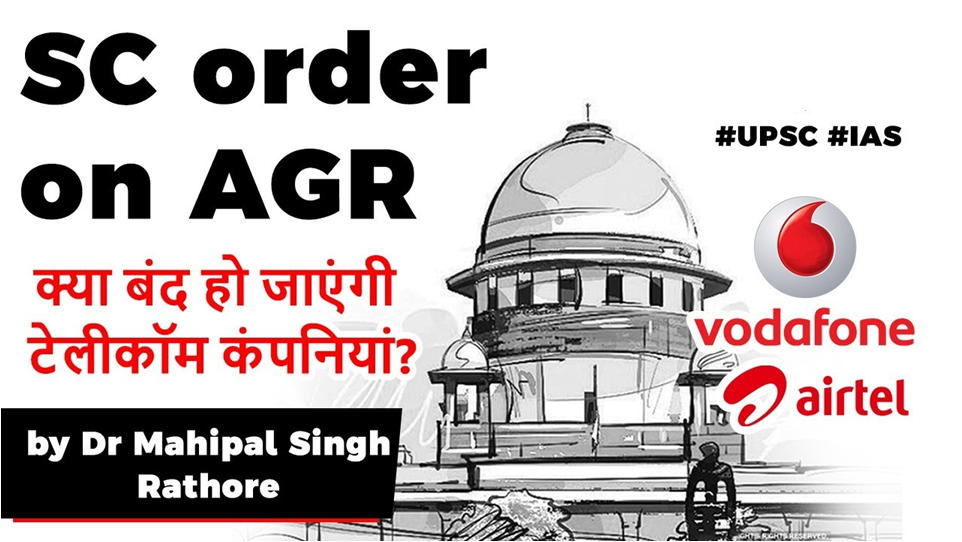Table of Contents
Question?
- The Government of India has constituted a Committee of Secretaries (CoS) to look for a relief package for the distressed telecom sector.
- Who is the head of this committee?
The Supreme Court Order
- The Supreme Court on 14th February 2020 pulled up mobile service operators and the department of telecommunications (DoT) for failing to comply with its earlier verdict, which mandated telecom companies to pay the adjusted gross revenue (AGR) dues of over ₹1 trillion to the DoT by 23 January.
- The Telcos were ordered to pay the dues by 14th Feb midnight.
Tough words
- ‘’The companies have violated the order passed by this court in pith and substance.
- In spite of the dismissal of the review application, they have not deposited any amount so far.
- It appears the way in which things are happening that they have scant respect to the directions issued by this court”
What is AGR?
- Adjusted Gross Revenue (AGR) is the usage and licensing fee that telecom operators are charged by the Department of Telecommunications (DoT).
- It is divided into
- Spectrum usage charges(SUC) – 3-5 %
- Licensing fees – 8 %
How is AGR calculated?
- As per DoT, the charges are calculated based on all revenues earned by a telco –
- Telecom services revenue – call, data, msging
- Non-telecom related sources – deposit interests , asset sales, dividends, handset sales, rent, profit from scrap sale,etc
- As per Telcos, AGR should comprise only the revenues generated from telecom services.
14-year-long court battle
- 2005, the Cellular Operators Association of India (COAI) challenged the government’s definition for AGR calculation.
- While telecom companies argued that it should comprise revenue from telecom services, the DoT’s stand was that the AGR should include all revenue earned by an operator, including that from non-core telecom operations
- 2015 – the Telecom Disputes Settlement and Appellate Tribunal(TDSAT) said AGR included all receipts except capital receipts and revenue from non-core sources such as rent, profit on the sale of fixed assets, dividend, interest and miscellaneous income, etc.
- The regulator has also included forex adjustment under AGR apart from ruling that licenses fee will not be charged twice on the same income.
- It, however, exempted bad debt, foreign exchange fluctuations, and sale of scrap to be calculated for AGR.
- The DoT, however, filed an appeal before the Supreme Court, citing that the TDSAT had no jurisdiction on the validity of terms and conditions of licenses.
- 2019 – The Supreme Court upheld the definition of Adjusted Gross Revenue (AGR) calculation as stipulated by the Department of Telecommunications.
How much do the companies owe?
- Telecom companies now owe the government not just the shortfall in AGR for the past 14 years but also an interest on that amount along with penalty and interest on the penalty.
- This means that telecom companies will have to pay up as much as Rs 92,642 crore to the government. (+46,000 crore as SUC)
- Of the total amount, it is estimated that the actual dues is about 25%, while the remaining amount is interest and penalties.

Companies affected
- Bharti Airtel ₹21,682 crore
- Vodafone idea ₹ 53,000 crore
- Reliance Jio ₹13 crore (entered the sector in 2016)
- BSNL ₹2,098 crore
- MTNL ₹2,537 crore
- Many other companies have exited the market.


Did the companies pay after October 2019 orders?
- No, they filed appeals.
- The Supreme Court agreed to hear the modification plea filed by telecom operators Vodafone Idea, Bharti Airtel, and Tata Teleservices on giving them more time to pay off dues.
- The deadline to pay off these dues was set as 23 Jan 2020.
- Controversial DoT order on 23 Jan.
- Again the Telcos filed for review.
Challenges for Telecom companies
- The industry’s debt currently stands at about ₹4 lakh crore.
- Due to intense competition from free voice and cheap data, the gross revenue of the telecom industry had fallen between 2017-18 and 2018-19.
- Currently, the price of data for the customer at an average of ₹8 per GB is almost the lowest in the world.
- Also, the average revenue per user per month has declined from ₹174 in 2014-15 to ₹113 in 2018-19.
Will government bail out the sector?
- The Government of India constituted a Committee of Secretaries (CoS), headed by theCabinet Secretary Rajiv Gauba, to look for a relief package for the distressed telecom sector.
- The panel will comprise of secretaries to the Ministries of Finance, Law, and Telecommunication.
What can be the impact of the SC ruling on Telecom sector?
- Huge impact on two private operators while most of the other impacted operators have exited the sector.
- The payout by telecom and non-telecom companies is likely to lead to windfall gains for the central government, which could help it close some of the fiscal deficit gap for the current financial.
- Government will be under pressure to ensure that the telecom market SURVIVES as it is one the highest revenue generating sectors and critical for development related schemes. (Aadhar, JAM, DBT)
- Duopoly
Non-telecom PSUs
- AGR demand from non-telecom companies is Rs 3 lakh crore.
- Nearly all of these are public sector units (PSUs)
- Gail
- Power Grid Corporation India
- Rail Tel
- Oil India
- Delhi Metro Rail Corporation
- The AGR demand is between two and three times their average revenue.
Latest Burning Issues | Free PDF






















 WhatsApp
WhatsApp